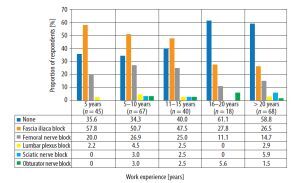PERIOPERATIVE MEDICINE / ORIGINAL ARTICLE
Standards of anaesthesia for total knee and hip arthroplasty procedures. A survey-based study.
Part II: Anaesthetic management
1
Centre for Intensive Care and Perioperative Medicine, Jagiellonian University Medical College, Krakow, Poland
2
Department of Intensive Care and Anaesthesiology, 5th Military Hospital with Polyclinic in Krakow, Poland
3
Department of Anaesthesiology and Intensive Care, Medical University of Gdansk, Poland
4
Department of Anaesthesiology and Intensive Care, Ludwik Rydygier Specialist Hospital in Krakow, Poland
5
Orthopaedic and Trauma Surgery Clinic, 5th Military Hospital with Polyclinic (Independent Public Health Care Institution) in Krakow, Poland
6
Department of Anaesthesiology and Intensive Care, Regional Hospital in Gorzow Wielkopolski, Poland
7
Fatebenefratelli Medical Center, Wroclaw, Poland
Submission date: 2024-09-12
Final revision date: 2025-01-05
Acceptance date: 2025-01-16
Corresponding author
Wojciech Szczeklik
Centre for Intensive Care and Perioperative Medicine, Jagiellonian University Medical College, Cracow, Poland
Centre for Intensive Care and Perioperative Medicine, Jagiellonian University Medical College, Cracow, Poland
Anaesthesiol Intensive Ther 2025;(1):4-10
KEYWORDS
hipkneearthroplastyTKAreplacementsurveys and questionnairesTHATJRanaesthesiological managementstandards of anaesthesia
TOPICS
ABSTRACT
Background:
Total knee arthroplasty (TKA) and total hip arthroplasty (THA) procedures are being performed more and more frequently. Since these procedures carry an indirect risk of perioperative complications, practice standards are warranted to minimise the incidence of adverse events. A survey-based study was carried out to identify the patterns of anaesthesiology practice in Polish hospitals.
Methods:
A survey was conducted among anaesthetists nationwide using the LimeSurvey application. The questions concerned the intraoperative and postoperative periods and focused mainly on the determination of anaesthetic methods for total joint replacement (TJR) procedures and postoperative pain management. Questionnaires included both single and multiple-choice questions.
Results:
A total of 258 responses from anaesthetists from 112 Polish healthcare institutions were included in the analysis. The subarachnoid block is performed by 86.0% of anaesthetists for TKA and 88.0% for THA. For TKA procedures, 30.6% of respondents state that they do not perform any additional peripheral block, and for THA this percentage is 44.6%. The most commonly performed peripheral nerve block for TKA is the femoral nerve block (46.5%) and for THA it is the fascia iliaca compartment block (42.6%). More than 90% of anaesthetists report routine use of systemic analgesics in TJR, with opioid use exceeding 80%.
Conclusions:
The study showed that anaesthetic perioperative care in Poland requires several modifications to better adhere to clinical standards. The most important issues include increasing the number of regional blocks, decreasing the use of opioid analgesics for post-operative pain management and introducing perioperative troponin screening.
Total knee arthroplasty (TKA) and total hip arthroplasty (THA) procedures are being performed more and more frequently. Since these procedures carry an indirect risk of perioperative complications, practice standards are warranted to minimise the incidence of adverse events. A survey-based study was carried out to identify the patterns of anaesthesiology practice in Polish hospitals.
Methods:
A survey was conducted among anaesthetists nationwide using the LimeSurvey application. The questions concerned the intraoperative and postoperative periods and focused mainly on the determination of anaesthetic methods for total joint replacement (TJR) procedures and postoperative pain management. Questionnaires included both single and multiple-choice questions.
Results:
A total of 258 responses from anaesthetists from 112 Polish healthcare institutions were included in the analysis. The subarachnoid block is performed by 86.0% of anaesthetists for TKA and 88.0% for THA. For TKA procedures, 30.6% of respondents state that they do not perform any additional peripheral block, and for THA this percentage is 44.6%. The most commonly performed peripheral nerve block for TKA is the femoral nerve block (46.5%) and for THA it is the fascia iliaca compartment block (42.6%). More than 90% of anaesthetists report routine use of systemic analgesics in TJR, with opioid use exceeding 80%.
Conclusions:
The study showed that anaesthetic perioperative care in Poland requires several modifications to better adhere to clinical standards. The most important issues include increasing the number of regional blocks, decreasing the use of opioid analgesics for post-operative pain management and introducing perioperative troponin screening.
Share
RELATED ARTICLE
We process personal data collected when visiting the website. The function of obtaining information about users and their behavior is carried out by voluntarily entered information in forms and saving cookies in end devices. Data, including cookies, are used to provide services, improve the user experience and to analyze the traffic in accordance with the Privacy policy. Data are also collected and processed by Google Analytics tool (more).
You can change cookies settings in your browser. Restricted use of cookies in the browser configuration may affect some functionalities of the website.
You can change cookies settings in your browser. Restricted use of cookies in the browser configuration may affect some functionalities of the website.



